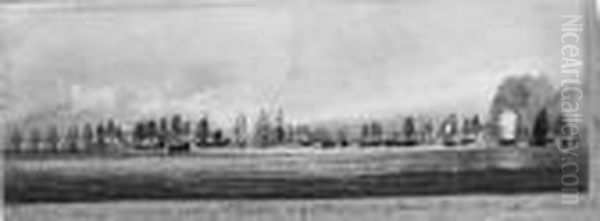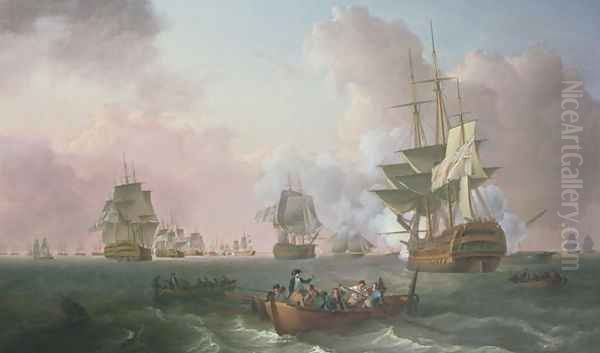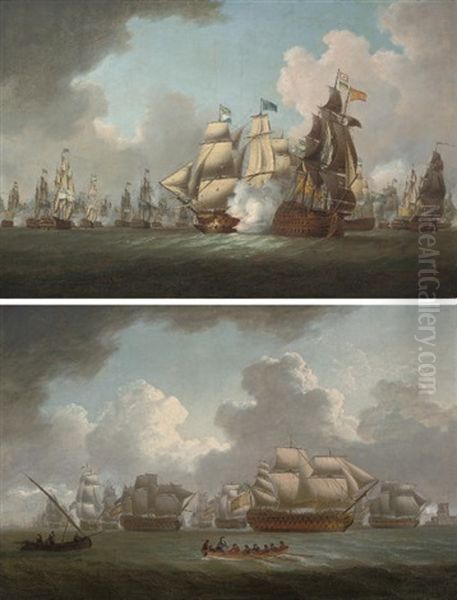Introduction: A Painter of Seas and Ships

William Anderson (1757-1837) stands as a significant figure in the tradition of British marine painting. Born in Scotland during a period of burgeoning national identity and increasing maritime power, Anderson carved a niche for himself with his meticulously detailed and evocative depictions of ships and coastal scenes. His work, deeply rooted in the technical accuracy fostered by his early experiences and profoundly influenced by the great Dutch marine painters of the 17th century, captured the essence of Britain's relationship with the sea during a pivotal era of naval history. He became particularly known for his portrayals of naval engagements and ship portraits, subjects that resonated strongly with the patriotic fervor of the late 18th and early 19th centuries.
Scottish Roots and Early Formation
William Anderson's journey as an artist began not in a studio, but likely amidst the practicalities of shipbuilding. Born in Scotland in 1757, his early life, though not extensively documented, is understood to have included training or work related to ship construction. This background provided him with an invaluable, intimate knowledge of naval architecture, rigging, and the very structure of the vessels he would later depict with such precision. Unlike artists who approached marine subjects purely from an aesthetic standpoint, Anderson possessed a craftsman's understanding of his subjects, allowing him to render ships with an authenticity that appealed to patrons familiar with the sea. This practical foundation distinguished his work and lent it a credibility that was highly valued.
This early immersion in the world of ships undoubtedly shaped his artistic eye. He learned the lines of a hull, the complex web of sails and ropes, and the way a vessel sat in the water under different conditions. This technical grounding would become a hallmark of his style, enabling him to create compositions that were not only visually appealing but also nautically convincing. While details of his formal art training remain scarce, his later work clearly shows a dedicated study of painting techniques, particularly those favoured by the Dutch masters he admired.
The Dutch Golden Age Influence

The most profound artistic influence on William Anderson was undeniably the legacy of the Dutch Golden Age marine painters, particularly the Van de Velde family. Willem van de Velde the Elder (c. 1611–1693) and his son, Willem van de Velde the Younger (1633–1707), had established a dominant tradition in marine art, renowned for its accuracy, atmospheric effects, and dramatic compositions. Their work was highly sought after in England, with both father and son eventually working for the English court. Anderson, like many British marine painters of his generation, looked to their example for inspiration and technique.
Anderson adopted the Dutch masters' meticulous attention to detail, especially in the rendering of ships. He studied their methods for depicting the play of light on water, the subtle variations in cloud formations, and the convincing representation of waves and sea spray. The influence is evident in his careful delineation of rigging, the accurate portrayal of flags and pennants, and the overall sense of realism that pervades his canvases. He often employed a calm, ordered compositional structure reminiscent of Van de Velde the Younger, favouring clear, well-lit scenes even when depicting naval actions. Artists like Ludolf Bakhuizen (1630–1708), known for his more dramatic and turbulent seascapes, also formed part of the Dutch tradition Anderson would have been aware of, though Anderson's temperament generally leaned towards the clarity of the Van de Veldes.
Artistic Style: Precision and Atmosphere
William Anderson's style is characterized by a blend of technical precision and atmospheric sensitivity. His background in shipbuilding endowed him with an exceptional ability to render the intricate details of warships and merchant vessels with remarkable accuracy. The hulls, masts, spars, and complex rigging are depicted with a clarity that speaks to his deep understanding of naval architecture. This precision was not merely technical; it served to create believable and engaging scenes, allowing viewers to appreciate the specific types of ships portrayed and the conditions under which they sailed.

Beyond the accuracy of the ships themselves, Anderson paid considerable attention to the setting. He often favoured calm or moderately choppy seas, rendered with careful observation of wave patterns and reflections. His skies are typically well-observed, featuring believable cloud formations that contribute to the overall mood of the painting. While perhaps not reaching the dramatic atmospheric heights of later artists like J.M.W. Turner (1775-1851) in his mature phase, Anderson skillfully used light and shadow to define form and create a sense of depth. His palette often relied on clear, luminous colours, sometimes incorporating the warm earth tones noted in descriptions of specific works, contributing to the overall harmony and realism of his compositions. Perspective was handled competently, ensuring that the spatial relationships between vessels and coastal elements felt convincing.
A Career in a Time of Conflict
Anderson's most productive and arguably most significant period as an artist coincided with the French Revolutionary Wars (1792–1802) and the Napoleonic Wars (1803–1815). This era saw unprecedented naval activity and a surge in British national pride centered on the Royal Navy's successes. Consequently, there was a high demand for marine paintings depicting naval battles, ship portraits, and coastal defence scenes. Anderson was well-positioned to meet this demand, bringing his technical skill and Dutch-influenced style to bear on subjects of great contemporary interest.
He began exhibiting at the prestigious Royal Academy of Arts in London in 1800, showcasing his work to a wider audience and establishing his reputation within the London art world, even if described as operating somewhat on its "fringes." He continued to exhibit regularly at the Academy until 1811, and then intermittently until 1834. This period, roughly from 1790 to 1810, is considered the peak of his career. His paintings from this time often depicted specific naval engagements or celebrated the power and presence of the British fleet. He worked alongside other prominent marine painters of the era, such as Nicholas Pocock (1740–1821) and Thomas Luny (1759–1837), who also specialized in chronicling Britain's naval exploits.
Subject Matter: Naval Power and Coastal Views
William Anderson's oeuvre primarily revolved around marine subjects, encompassing a range of themes popular during his time. Naval engagements were a key focus, capturing the drama and patriotic significance of battles fought during the wars against France. While specific titles mentioned in some sources like The Battle of Waterloo or The Battle of Finschhafen seem highly improbable for a marine specialist focused on the Napoleonic naval era (Waterloo being a land battle and Finschhafen a location relevant much later in history), other attributed works align perfectly with his known interests and the period. Paintings depicting The Capture of Louisburg (likely referring to the 18th-century captures), The Martinique Campaign of 1794, or scenes related to the Battle of Trafalgar (1805) would fit squarely within his likely output, celebrating British naval victories.

Beyond battle scenes, Anderson excelled at ship portraits. These works often depicted specific naval vessels, sometimes in multiple positions to showcase their design and rigging, as exemplified by the title An English Third Class Ship of the Line in Three Positions. Such paintings required immense accuracy and appealed to naval officers, ship owners, and collectors interested in maritime affairs. He also painted numerous coastal and harbour scenes, often featuring identifiable locations. Works like The Landscape of Berwick-upon-Tweed and The Scenery of Tynemouth demonstrate his skill in integrating landscape elements with maritime activity, capturing the bustling life of ports or the tranquil beauty of the coastline, often populated with smaller craft and figures that add scale and interest. These calmer scenes showcase his ability to render light and water with subtlety, echoing the Dutch tradition of peaceful harbour views by artists like Jan van Goyen (1596-1656).
Representative Works: A Closer Look
While a comprehensive catalogue raisonné might be lacking, certain works and descriptions provide insight into Anderson's approach. The painting titled An English Third Class Ship of the Line in Three Positions is particularly illustrative. The very title suggests a focus on technical depiction, aiming to show the vessel from different angles, likely appealing to a knowledgeable audience interested in naval design. Descriptions mention his use of perspective and warm earth tones in this work, highlighting his attention to both structural accuracy and painterly qualities. Such works served not just as art but almost as technical documents, celebrating the engineering and aesthetic qualities of these powerful warships.
His coastal views, such as those depicting Berwick-upon-Tweed or Tynemouth, would have showcased his ability to capture specific topography and local atmosphere. These paintings often included detailed renderings of smaller boats, dockside activities, and figures, bringing the scenes to life. They reflect a broader tradition in British art of depicting the nation's landscape and coastline, a genre also explored by contemporaries like Philip James de Loutherbourg (1740-1812), though de Loutherbourg often favoured more dramatic, sublime effects. Anderson's coastal scenes, by contrast, typically maintained a sense of clarity and order, emphasizing the harmonious relationship between human activity and the natural environment. His depictions of harbours and estuaries, filled with shipping, connect to a long tradition stretching back to the Dutch masters and carried forward by British artists.
Place within British Marine Painting
William Anderson occupied an important place within the evolution of British marine painting. He worked during a period when the genre was flourishing, fueled by national events and a growing appreciation for the sea's role in British life and power. He represented a continuation of the detailed, realistic tradition heavily influenced by the Dutch Van de Veldes, a style that remained popular throughout the 18th century and into the early 19th. Artists like Charles Brooking (1723–1759), though earlier, had helped establish this Dutch-influenced school in Britain, and Anderson followed capably in this lineage.
Compared to some of his contemporaries, Anderson's work might be seen as less overtly dramatic than the proto-Romantic compositions of de Loutherbourg or the later, revolutionary seascapes of Turner. His strength lay in clarity, precision, and a consistent, high level of craftsmanship. He provided patrons with accurate and aesthetically pleasing records of naval power and coastal life. His career bridged the era of the meticulously detailed ship portrait, exemplified by artists like Dominic Serres (1719–1793), and the burgeoning Romantic movement, although his own style remained largely anchored in the earlier tradition. Later marine painters like Clarkson Stanfield (1793–1867) would build upon the foundations laid by artists like Anderson, developing the genre further in the Victorian era.
Influence and Legacy
While perhaps not as widely influential as some of the towering figures of British art, William Anderson's work did leave its mark. His dedication to accuracy and his skillful adaptation of the Dutch style provided a model for subsequent marine painters. Notably, the Hull-based marine artist Henry Redmore (1820–1887) is often cited as having been influenced by Anderson. Redmore's own detailed depictions of shipping and coastal scenes, which also show a clear debt to Dutch traditions, suggest he may have studied Anderson's work. Anderson's paintings helped perpetuate the high standards of technical accuracy combined with atmospheric sensitivity that characterized the best of the Dutch-influenced British marine school.
Today, William Anderson's paintings are held in various public and private collections, particularly those specializing in maritime art, such as the National Maritime Museum in Greenwich, London. His works continue to appear at auction, appreciated by collectors for their historical significance, detailed execution, and representation of a key period in British naval history. He is remembered as a highly competent and dedicated specialist, a Scottish artist who made a significant contribution to the field of marine painting in Britain through his skillful rendering of ships and his adherence to the enduring traditions of the Dutch masters. His legacy lies in the quality of his surviving works, which offer valuable visual records of the ships and seascapes of his time, executed with a craftsman's knowledge and an artist's eye.
Conclusion: Chronicler of Britain's Maritime Age
William Anderson navigated the currents of the British art world in the late 18th and early 19th centuries with skill and dedication. As a specialist marine painter, he capitalized on the nation's intense interest in naval affairs during a period of protracted conflict and growing imperial reach. His Scottish origins and foundational knowledge of shipbuilding gave his work a distinctive authenticity, while his admiration for and study of the Dutch Golden Age masters, especially the Van de Veldes, provided him with a robust stylistic framework. Through countless canvases depicting warships, merchant vessels, naval battles, and coastal scenes, he chronicled Britain's relationship with the sea. Exhibiting regularly at the Royal Academy, he solidified his reputation as a master of maritime detail and atmospheric effect. Though perhaps overshadowed by more revolutionary figures, Anderson remains a significant artist whose work provides a vital and visually compelling window onto the maritime world of his era, influencing later painters like Henry Redmore and securing his place in the history of British marine art.